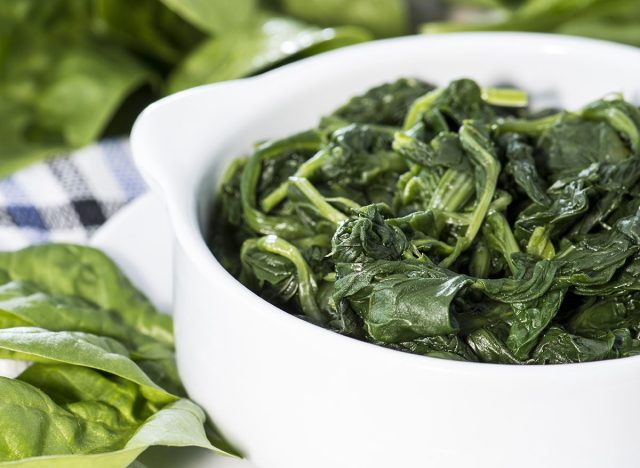You have heard over and over throughout your life how important it is to eat the proper serving of vegetables each day. And as you get older, produce becomes even more integral to your long-term health. While all fruits and vegetables can support your overall health, there is one type of veggie that you should definitely keep in your meal rotation after you hit 50.
“If I am picking one vegetable I will pick leafy greens, specifically spinach,” says Amy Goodson, MS, RD, CSSD, LD, a registered dietitian on our medical expert board and author of The Sports Nutrition Playbook.
The reason Goodson recommends spinach to those over 50 is that the leafy green is a good source of nutrients that are particularly beneficial as you age, namely calcium, vitamin B12, and potassium.
“Adults over age 50 have increased nutrient requirements for a handful of vitamins and minerals to help support healthy aging,” Goodson explains. “Specifically, they need more calcium to help maintain bone mineral density as they age, more vitamin B12 due to the fact that absorption typically declines with age, and potassium, which is a nutrient of concern for all Americans,” she continues, separately noting that high-quality protein is another important nutrient to prioritize as you age in order to maintain lean muscle mass.
Spinach happens to be a triple threat when it comes to these healthy aging-supporting nutrients. “While one vegetable will not give you the total amount of all three nutrients that you need more of according to the Dietary Reference Intake Recommendation (DRI), leafy greens like spinach top the charts when it comes to providing all three,” says Goodson. “[Leafy greens] provide calcium, potassium, and some vitamin B12. In addition, they also provide fiber, which is important for gut and heart health as well as antioxidants, which are important for helping the body fight inflammation.”


While spinach ranks as the best vegetable to load up on after you push past 50, Goodson stressed that you still need a balanced diet in order to get the maximum serving of nutrients found in spinach.
“What’s interesting is that many of these nutrients are not high in vegetables,” Goodson says. “The best sources of calcium are dairy foods like milk, cheese, and yogurt. The best sources of Vitamin B12 are primarily found in animal proteins like beef, liver, fish, eggs, dairy foods, as well as fortified cereals. The best sources of potassium are, however, found in fruits and vegetables in addition to dairy foods like milk and yogurt.”
READ RELATED: Sherfane Rutherford Height, Weight, Age, Body Statistics
But even if you can’t get the maximum serving of any of these nutrients in one vegetable, you really can’t go wrong when you rely on spinach as a supplemental vegetable in your diet.
How to eat more spinach
Anyone who loves to cook can take heart knowing how great spinach is as you age, and you can tap into a variety of recipes in order to get the best bang for your buck when it comes to this type of produce.
“Green leafy vegetables can be scrambled into eggs at breakfast, used to make a salad at lunch and can be a side dish for any protein. Bonus, spinach can even be blended into a fruit smoothie for an extra pop of nutrients!”
If you don’t count yourself as much of a cook, you can’t go wrong by trying out The Easiest Garlic-Lemon Spinach Recipe for a foolproof way to introduce more of this leafy green into your life.
Source:









